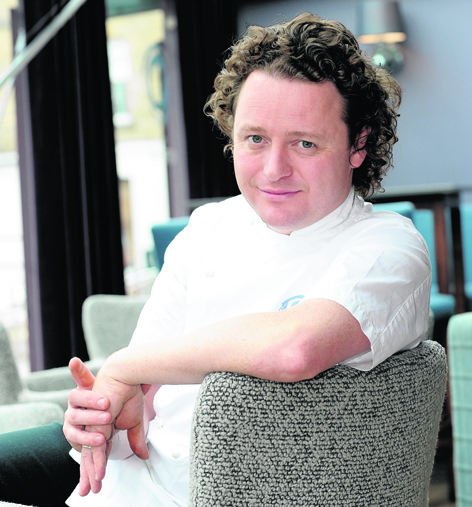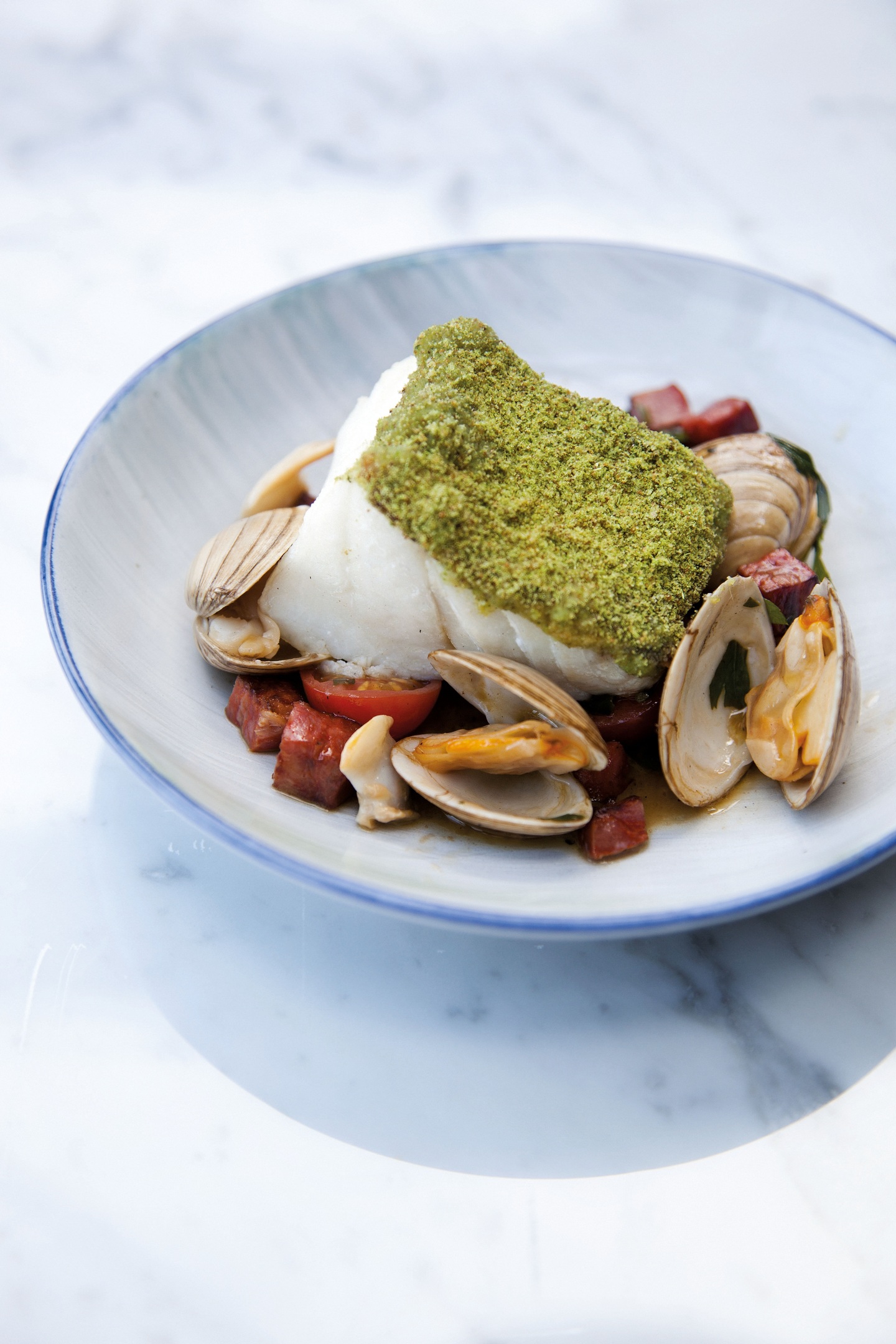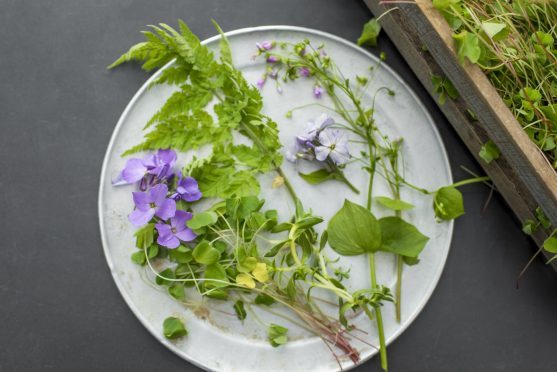Spring is a great time to make the most of fresh, local herbs.
They can pack real punch and depth of flavour to dishes, and there are so many different ways you can use them, marrying them with the best of the season’s produce.

They can be the star of a dish such as a seasonal fresh herb velouté, or they can make a lovely garnish giving a dish that extra finishing touch in colour, presentation and flavour. I’ve been using fresh spring herbs in my kitchen at home to create some fresh herb infused oils as it’s a great way to use up fresh herbs you’ve either bought or grown.
I’ve also been enjoying some different herb crumb coatings, to marry with the best of the season’s meat and fish. They make the perfect simple supper – easy and quick to make and they offer a brilliant way to lift a dish. They keep things fresh and natural, avoiding the use of too much salt, sugar or ready-made sauces or stocks.
All you need to create a delicious herb crumb is your favourite seasonal herbs, and some leftover bread. You can keep it in the fridge to add to a quick mid-week supper and it’s a brilliant way to use up any leftover herbs you might otherwise throw away.
If you’re not sure which herbs to use, consider ones that will stand up to the intense heat of the pan, but don’t overpower the produce you’re preparing. I recommend trying tarragon because it has a lovely distinct flavour, or parsley is another great one.
A combination of thyme, sage and rosemary can be a really fresh addition but I recommend you combine all three together, as alone they can sometimes overpower the meat or fish.
Making your own batch of this crunchy herb crumb coating really is a quick and easy way to transform humble ingredients into flavoursome supper dishes.
Fillet of Cod with Herb Breadcrumbs, Chorizo and Clams
SERVES 4

The ingredients
- 250g surf of venus clams in shell
- 4 chunky portions of cod fillet, about 200g each
- 150g white bread (ideally day old), crusts removed, torn into chunks
- 1 tablespoon chopped tarragon
- Sea salt and freshly ground black pepper
- Olive oil for cooking
- 1 tablespoon Dijon mustard
- 50g chorizo, skinned and roughly chopped
- 2 garlic cloves, peeled and chopped
- 50ml white wine
- 1 tablespoon chopped parsley
- A little extra virgin olive oil
- 12 cherry tomatoes, halved
- 1 tablespoon chopped basil
The method
- Rinse the clams thoroughly under cold running water for 5-10 minutes to remove all grit. Drain and set aside. Have the cod portions ready at room temperature.
- For the herb breadcrumbs, put the bread and chopped tarragon into a blender and blitz to fine crumbs; the breadcrumbs will take on a lovely green colour. Tip them into a shallow dish and set aside.
- Heat the oven to 180°C/Gas 4. Season the cod portions all over with salt and pepper. Heat a large non-stick ovenproof frying pan over a medium-high heat and add a drizzle of olive oil.
- When hot, place the cod portions, skin side down, in the pan and cook for 2-3 minutes until the skin starts to crisp. Transfer the pan to the oven and roast the cod for 4-5 minutes. Take out of the oven and carefully turn the cod skin side up.
- Using a pastry brush, coat the skin with Dijon mustard. Now dip the skin side into the herb breadcrumbs to coat evenly.
- Replace the cod portions in the pan, crumbed side up, and bake for a further 1-2 minutes. While the cod is in the oven, cook the clams. Heat a non-stick sauté pan or deep frying pan and add a drizzle of olive oil. Add the chorizo pieces and cook for 2-3 minutes.
- Tip in the clams and add the garlic, white wine and chopped parsley. Immediately cover with a tight-fitting lid and cook for 2-3 minutes until the clams steam open.
- When the cod portions are cooked, remove them from the oven and set aside to rest in a warm place for a few minutes.
- Once the clams are open, remove them with a slotted spoon to a bowl, leaving the chorizo and juices in the pan. Tip in any juices from the rested cod. Bring to the boil and let bubble for a minute or two to reduce the liquor.
- Add a splash of extra virgin olive oil to thicken it further, along with cherry tomatoes and basil. Spoon the sauce over the clams. Divide between warm bowls, placing the cod in the middle.
Hake Served With Wild Herb Crust
SERVES 4
The ingredients
- 1 medium/large side of hake
- 20g wild herbs (sweet cicily, chick weed, pink purslane)
- Parsley
- 6 slices wholemeal bread
- Sea salt & cracked black pepper
- 25g unsalted butter, softened
- 12g parmesan grated
- Vegetable oil for cooking
The method
- Remove the pin bones from the hake and remove the scales (you can ask your fishmonger to do this for you). Cut into 4 equal portions then place in the fridge for later.
- For the crust, use a selection of wild herbs and also some parsley. Pick the leaves from the stalks and discard the latter. Cut the crusts off the slices of bread and dice into approx 1cm cubes.
- Put the bread into an electric blender and mix on full power until the bread starts to turn sticky and hot.
- Add the herbs and a pinch of salt and continue to blend on full power for about 3 minutes, or until it is smooth and bright green. Continue blending and add the butter a little at a time.
- Finally mix in the parmesan. Taste the crust and adjust the seasoning if needed.
- Spread the crust between two sheets of greaseproof paper into an even layer about 3mm thick then place in the freezer to set. Leave for 1 hour.
- Portion 4 pieces of herb crust to the same size as the portions of hake. Place in the fridge, and remove 10 minutes before cooking. Heat the oven to 180°C and turn on the grill.
- To cook the hake, heat about 2 tablespoons of oil in a large, heavy bottomed pan over a large heat. Pat the skin of the fish dry with kitchen paper, then season generously all over with sea salt. Place the fillets of hake into the pan, pressing down gently to ensure contact with the pan.
- Sear on the skin side for 1 minute over a high heat until golden, then place in the oven for 3 minutes. Remove from the oven and add butter, foam and baste the fish for 10 seconds.
- Turn the fillets over, then place the portioned herb crust on top. Put the fish under the grill until the crust is just crisp. Serve immediately.
Herb Infused Vegetable Oil
The ingredients
- 2 sprigs for each infusion & 1 for decoration after infusion
- Vegetable oil (enough to fill your bottle)
- I usually prefer to use basil, mint, bay leaves, chives, dill, rosemary, sage, oregano, thyme or tarragon, but most herbs work. You can also use dry herbs, but I prefer fresh ones for more flavour.
The method
- Clean a few glass bottles out if you want to create a few different flavours at the same time. Bruise your herbs carefully and place them into the bottle. Use a mortar if you find this technique easier.
- Gently heat the oil on a low temperature until it is warm (do not cook the oil). Once the oil is warmed, gently pour it into your prepared herbal bottles, covering all the herbs completely with the oil.
- Seal the bottle or jar with an airtight seal. Keep the bottles in a cool, dark and dry place for at least a week to allow the herbal oils to be created.
- After a week, strain the herb mix completely once the oil has been fully infused, by using a thin muslin or sieve. Take a fresh sprig of herb and place it in the bottle and pour the new infused oil over it. I recommend you use the oil within a two month period.
